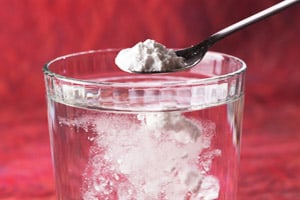2018 update:
 The 2015 study below was the first study I’m aware of that looked specifically at female physique athletes and the effects of a higher protein intake, and comes from Dr. Bill Campbell’s lab via the University of South Florida, Performance & Physique Enhancement Laboratory, which I gave a talk at in 2016 and presented at conferences. It’s interesting to note they found increased LBM with higher protein off season.
The 2015 study below was the first study I’m aware of that looked specifically at female physique athletes and the effects of a higher protein intake, and comes from Dr. Bill Campbell’s lab via the University of South Florida, Performance & Physique Enhancement Laboratory, which I gave a talk at in 2016 and presented at conferences. It’s interesting to note they found increased LBM with higher protein off season.
A new study looked at female physique athletes, and the effects of a high vs. low protein intake. This new study by some of the same authors of the prior study, found although strength of the athletes didn’t vary (reach statistical significance), they did find improved bodycomp in the high protein group. If trying to increase FFM and limit BF, eat your protein ladies!
Effects of High vs. Low Protein Intake on Body Composition and Maximal Strength in Aspiring Female Physique Athletes Engaging in an 8-Week Resistance Training Program.
Int J Sport Nutr Exerc Metab. 2018 Feb 6:1-21. doi: 10.1123/ijsnem.2017-0389.
Abstract
Effects of a high (2.4 g/kg) vs. low/moderate (1.2 g/kg) protein intake on body composition in aspiring female physique athletes engaging in an 8-week resistance training program
University of South Florida, Performance & Physique Enhancement Laboratory, Tampa, FL, USA
Background
Aspiring female physique athletes are often encouraged to ingest relatively high levels of dietary protein in conjunction with their resistance-training programs. However, there is little to no research investigating higher vs. lower protein intakes in this population. The purpose of this investigation was to compare the effects of a high protein diet vs. a low protein diet in resistance trained, aspiring female physique athletes.
Methods
17 resistance-trained female subjects (21.2±2.1 years; 165.1±5.1 cm; 61±6.1 kg) participated in this investigation. At baseline and following 8-weeks of a periodized daily undulating resistance-training program (DUP), participants were assessed for body composition (body weight [BW], fat mass [FM], body fat % [BF%], and lean body mass [LBM]). After baseline testing, participants were matched according to total FM and randomized to the high protein group (HP; n = 8) or the low/moderate protein group (LP; n = 9). Participants in the high protein group were instructed to ingest at least 2.4 grams of protein/kg body mass per day and participants in the low protein group were instructed to ingest no more than 1.2 grams of protein/kg body mass. There were no restrictions or guidelines placed on dietary CHO or Fat intake during the study intervention for either group. Body composition was assessed via ultrasound (A mode, 2.5-MHz transmitter). The DUP program consisted of two lower body and two upper body workouts conducted a total of 4 times per week for 8 weeks. Data were analyzed via a 2-factor [2×2] between-subjects repeated measures analysis of variance (ANOVA). The criterion for significance was set at p ≤ 0.05.
Results
No differences existed between the two groups for any body composition measure at baseline. The repeated measures ANOVA revealed a significant group x time interaction for lean body mass (p = 0.009) favoring the high protein group. Specifically, lean body mass increased from 47.1 ± 4.5kg to 49.2 ± 5.4kg and from 48.1 ± 2.7kg to 48.8 ± 2 in the high and low protein groups, respectively. There were no differences between the groups for BW (HP: Pre = 61.2 ± 7.9kg, Post = 62.2 ± 8.2kg, LP: Pre = 61.4 ± 4.4kg, Post = 61.2 ± 4.6kg, p = 0.120); FM (HP: Pre = 14.1 ± 3.6kg, Post = 13.0 ± 3.3kg, LP: Pre = 13.2 ± 3.7kg, Post = 12.5 ± 3.0kg, p = 0.678), or BF% (HP: Pre = 22.7 ± 3.0%, Post = 20.7 ± 3.1%, LP: Pre = 21.4 ± 5.2%, Post = 20.3 ± 3.9%, p = 0.349).

BrinkZone Author Monica “Brains and Body” Mollica shows what plenty of protein and hard work looks like
Conclusions
In aspiring female physique athletes, it appears as if a higher protein diet (at least 2.4g/kg day) is superior to a lower protein diet in terms of increasing lean body mass in conjunction with a DUP program. It is important to note that these findings were observed during a non-dieting phase of training – equivalent to a physique athlete’s off-season. There does not appear to be any advantages to a higher protein diet in relation to inducing fat loss under the same conditions.
Will Brink is the owner of the Brinkzone Blog. Will has over 30 years experience as a respected author, columnist and consultant, to the supplement, fitness, bodybuilding, and weight loss industry and has been extensively published. Will graduated from Harvard University with a concentration in the natural sciences, and is a consultant to major supplement, dairy, and pharmaceutical companies.
His often ground breaking articles can be found in publications such as Lets Live, Muscle Media 2000, MuscleMag International, The Life Extension Magazine, Muscle n Fitness, Inside Karate, Exercise For Men Only, Body International, Power, Oxygen, Penthouse, Women’s World and The Townsend Letter For Doctors.
He’s also been published in peer reviewed journals.
Will is the author of the popular e-books, both accompanied by private members forum access , Bodybuilding Revealed & Fat Loss Revealed.
You can also buy Will’s other books on Amazon, Apple iBook, and Barnes and Noble.






Very interesting results and I’m not surprised by them! Can we infer that physically active people of both sexes benefit from a higher protein diet?
Data has been very consistent that well higher than RDA levels of protein are a benefit on various fronts.
So someone finally ran the experiment right. Nice.
Used resistance trained athletes, and real world conditions.
Will, what’s your thoughts on extrapolating that protein intake to other body sizes and body fat levels?
Would you assign protein intake based on grams per kg lean mass, or stay with bodyweight even in obese trainees?
If as I suspect, it’s the former, then the equivalent levels of 1.5 and 3.0 grams per kg lean mass would apply regardless of body fat levels.
Lastly, any thoughts on male trainees?
Or, would you do this by ideal body weight?
I’d use bodyweight per this and the many other studies that generally find superior effects on body comp with higher P diets. Unless the person is morbidly obese, the differences in cals will be minimal using anything but bodyweight will be minimal and not worth the effort.
My Fat Loss Revealed and Bodybuilding Revealed programs go into much more depth if interested, and there’s a ton of free articles and vids here you can check out also.
Good luck!
Ok, Will. thanks!
And how much of the 2.4 gr/kg ingested is utilized with full spectrum of A/A’s ??? Or, without A/A’S??? Thanks! Rick
How are you defining “utilized” ? Not sure I follow the Q in the context of the study and its results.
Is there any data on high protein diet and bone loss? I’ve read both sides. Some say the extra acid load is balanced by more calcium release. Others say this is not so.
Yes, study just done by Jose Antonio found no bone loss, and data early data that suggested bone loss was epi/correlational vs direct intervention, so no cause an effect can be made. See my article on protein myths and sarcopenia for more info. Study:
“Despite an 87% higher protein intake (high-protein versus control), 6 months of a high-protein diet had no effect on whole body bone mineral density, lumbar bone mineral density, T-scores, lean body mass or fat mass.”
https://jissn.biomedcentral.com/articles/10.1186/s12970-018-0210-6
Wait, this last study was funded by Dymatize?!
Will….!!!
Good catch. I have found the studies to be inconsistent on this matter.
And? I know the researcher who did the study well, and he’s not gonna fib or fabricate data for any company due to funding. I worry more about who does a study vs who funds it personally.